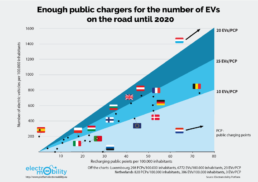Enough public chargers planned; infrastructure can’t be blamed for the slow uptake of EVs – analysis
Enough public chargers planned; infrastructure can’t be blamed for the slow uptake of EVs – analysis
More investment in public charging infrastructure needed after 2020 as electric vehicle sales increase.
Contrary to mainstream belief that there are not enough electric vehicle chargers and that this is discouraging potential EV buyers, a new analysis reveals sufficient public recharging facilities for the number of cars on the road in 2017 in many countries. Furthermore, if national EV infrastructure roll-out plans are met there will also be sufficient EV chargers until 2020.

The analysis by the Electromobility Platform [1] confirms that for passenger cars it is not the lack of infrastructure but rather the limited availability of electric vehicles that is responsible for low vehicles sales – 1.4% of new car sales in the EU in 2017. The Electromobility Platform is a partnership uniting organisations from across civil society, industries, and transport modes to promote the shift to all forms of electric transport.
The analysis found that on average there were five electric vehicles on the road per public charging point in 2017 in Europe, more than recommended by the European Commission [2]. However the European average ratio masks locations of over and under supply where further investment is needed.
If EU countries deliver on their plans for the roll-out of public charging infrastructure there will be around 10 EVs per charger by 2020, also in line with the Commission target. But further investment in public charging points (PCPs) will be required both before and after 2020 as electric vehicle sales increase.
Marie-France van der Valk, Head of the Brussels Renault-Nissan Alliance Office and Chairwoman of the Platform for Electro-mobility, said: “The European Member States are taking the right turn on electro-mobility and the EV market is starting to develop in an encouraging way. But full electro-mobility momentum can only be achieved together, with all of the EU members taking real initiatives for more infrastructure, green public procurement and actively supporting the shift to a low-carbon economy.”
The Platform analysis also shows that there will be at least one high power charging station every 40km on key European highways, a continental road network known as the TEN-T Comprehensive network, by 2020. This is more than the Commission’s recommendation of one charging station every 60 km. However, beyond 2020 increased numbers of charging points will be needed in some locations.
Electromobility not only helps drastically reduce climate-changing emissions from vehicles, but is also crucial to cut noise and air pollution levels in urban areas. Public authorities can provide a lead in supporting the shift to zero-emission transport and should be encouraged and supported to do so.
Nicolas Erb, Director of European Public Affairs for Alstom and Vice-Chair of the Platform, said: “By setting national targets for the public procurement of clean vehicles by 2025 and 2030, the directive currently being discussed in Parliament and Council is a major opportunity to boost zero-emission vehicle operations in European cities. Electric buses, taxis and delivery vehicles will help tackle the air pollution crisis in European cities and provide a market for clean European vehicles, strengthening the competitiveness of our industry.”
The Electromobility Platform will present the key findings of its new analysis today in a public event in the European Parliament at 5pm (Brussels time), in the presence of the Transport Commissioner Violeta Bulc.
Matthijs van Miltenburg MEP, host of the Platform event, said: “Europe needs to be a climate and technology leader. Electromobility helps achieve both strategic objectives. Europe should set a suite of ambitious policies to drive the economic and environmental benefits electromobility offers.”
Footnotes:
[1] The Platform for Electro-Mobility is an European alliance of 31 producers, infrastructure managers, operators, transport users, cities and civil society organisations from across industries and transport modes. The Platform advocates the acceleration of electrification of all modes of transport. The vision of the Platform for Electro-mobility is a sustainable, multimodal transport system in which people and goods are predominantly moved across land in Europe using sustainable electricity.
Current Members of the Platform: ABB, Alstom, Avere, Bellona, BlueSolutions, CER, CHAdeMO, Change Partnership, ChargePoint, European Cyclists Federation, ECOS, EIM, Enel, ENTSO-E, EURELECTRIC, Eurobat, European Copper Institute, London EV Company, Polis, RATP, Renault-Nissan, SmartEn, Siemens, SolarPower Europe, Tesla, 3M, Transport & Environment, UFE, UITP, Unife and Wind Europe.
[2] The European Commission recommends 10 EVs per public charging infrastructure, but this ratio will vary widely between locations and in particular whether private parking is available.
Commission shift to electrified transport on the right track
Commission shift to electrified transport on the right track
says Platform for Electro-Mobility
The Platform for Electro-mobility welcomes the Commission’s Strategy for Low Emission Mobility in driving the shift to clean, low carbon transport powered by electricity. Integrating all type of emissions is one key element of the uptake of electric vehicles, especially in cities and urban areas, allowing local and regional authorities to better comply with other European standards beyond CO2 emissions.
In its representations to the Commission, the Platform highlighted that electro-mobility provides a huge opportunity for innovation and job creation and allows Europe to reduce its dependency on imported oil. 94% on energy use in transport is oil and the shift away from this is recognised in the Strategy with one of the three pillars focused on “Low-emission alternative energy for transport.” This transformation can create over a million additional jobs and reduce the millions of euros of costs of transport-related air pollution emissions.
Platform Chair Senan McGrath said, “The Strategy recognises the pivotal potential for electro-mobility in the EU’s low emissions transport strategy. Now we need this translated into concrete actions to end road transport’s addiction to oil and encourage the shift to low emissions electric multimodality. In doing so there is a unique opportunity for European business to be at the forefront of delivering clean, green and energy efficient mobility. We look forward to working with the Commission in developing these proposals.”
Key announcements welcomed by the Platform include recognition that to achieve widespread adoption of electric vehicles, charging infrastructure needs to become widely available throughout Europe and that financing opportunities through the European Fund for Strategic Investments will be further exploited to achieve this. The Platform also welcomes the emphasis upon open cross border and EU-wide electro-mobility services market for consumers including providing real-time information on public charging points and supporting interoperable payment systems. The need to facilitate integration of electric vehicles with smart grids based on innovative technologies and advanced market rules will be key to further accelerate overall adoption of electro-mobility and must be a feature of the forthcoming Energy Market Reform.
The Platform was also pleased that the Strategy recognises that “transformational change towards low- and zero-emission vehicles will need to be supported by a wide range of measures at all levels of policy-making to engage both manufacturers and users.” Also, that it recognises the importance of electric rail services for both passengers and freight.
However, the Platform is disappointed that the Strategy has a limited focus on ways to reduce emissions in urban environments, including through the use of light electric vehicles such as scooters and e-bikes, and the lack of concrete measures proposed in this crucial area of action.
Senan McGrath concluded, “The shift to electro-mobility requires action at the EU, national and local level and by the public and private sectors working in their common interests. The Commission has signaled it is persuaded and the members of the Platform are working to make this a growing reality. Now we need all EU Member States to embrace the agenda with the common commitment to enable clean electricity to become the dominant energy source for transport both within and between cities.”
Note to editors:
The Platform for Electro-Mobility (www.platformelectromobility.eu) is a European alliance of over 20 producers, infrastructure managers, operators, transport users, cities and civil society organizations from across industries and transport modes. The Platform advocates the acceleration of electrification of all modes of transport, focusing on its numerous benefits, such as emission reduction, efficiency gains, support for technological innovation, jobs and growth through value creation in Europe as well as reducing Europe’s energy dependence from fossil fuel imports. The vision of the Platform for Electro-mobility is a sustainable, multimodal transport system in which people and goods are predominantly moved across land in Europe using sustainable electricity.”

